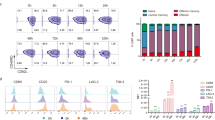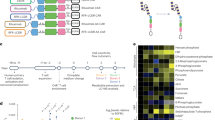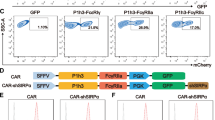Abstract
Collaborator of ARF (CARF) was cloned as an ARF-interacting protein and shown to regulate the p53–p21WAF1–HDM2 pathway, which is central to tumor suppression via senescence and apoptosis. We had previously reported that CARF inhibition in cancer cells led to polyploidy and caspase-dependent apoptosis, however, the mechanisms governing this phenomenon remained unknown. Thus, we examined various cell death and survival pathways including the mitochondrial stress, ataxia telangiectasia mutated (ATM)–ATR, Ras–MAP kinase and retinoblastoma cascades. We found that CARF is a pleiotropic regulator with widespread effects; its suppression affected all investigated pathways. Most remarkably, it protected the cells against genotoxicity; CARF knockdown elicited DNA damage response as evidenced by increased levels of phosphorylated ATM and γH2AX, leading to induction of mitotic arrest and eventual apoptosis. We also show that the CARF-silencing-induced apoptosis in vitro translates to in vivo. In a human tumor xenograft mouse model, treatment of developing tumors with short hairpin RNA (shRNA) against CARF via an adenovirus carrier induced complete suppression of tumor growth, suggesting that CARF shRNA is a strong candidate for an anticancer reagent. We demonstrate that CARF has a vital role in genome preservation and tumor suppression and CARF siRNA is an effective novel cancer therapeutic agent.
Similar content being viewed by others
Log in or create a free account to read this content
Gain free access to this article, as well as selected content from this journal and more on nature.com
or
Abbreviations
- CARF:
-
collaborator of alternative reading frame
- RB:
-
retinoblastoma
- ATM:
-
ataxia telangiectasia mutated
- ATR:
-
ataxia telangiectasia mutated- and Rad3-related
- MAPK:
-
mitogen-activated protein kinase
References
Aylon Y, Oren M . Living with p53, dying of p53. Cell 2007; 130: 597–600.
Hasan MK, Yaguchi T, Sugihara T, Kumar PK, Taira K, Reddel RR et al. CARF is a novel protein that cooperates with mouse p19ARF (human p14ARF) in activating p53. J Biol Chem 2002; 277: 37765–37770.
Hasan K, Cheung C, Kaul Z, Shah N, Sakaushi S, Sugimoto K et al. CARF is a vital dual regulator of cellular senescence and apoptosis. J Biol Chem 2009; 284: 1664–1672.
Castedo M, Perfettini JL, Roumier T, Andreau K, Medema R, Kroemer G . Cell death by mitotic catastrophe: A molecular definition. Oncogene 2004; 23: 2825–2837.
Vakifahmetoglu H, Olsson M, Zhivotovsky B . Death through a tragedy: Mitotic catastrophe. Cell Death Differ 2008; 15: 1153–1162.
Buchmann AM, Swaminathan S, Thimmapaya B . Regulation of cellular genes in a chromosomal context by the retinoblastoma tumor suppressor protein. Mol Cell Biol 1998; 18: 4565–4576.
Coqueret O . New roles for p21 and p27 cell-cycle inhibitors: A function for each cell compartment? Trends Cell Biol 2003; 13: 65–70.
Karreth FA, Tuveson DA . Modelling oncogenic ras/raf signalling in the mouse. Curr Opin Genet Dev 2009; 19: 4–11.
Bartek J, Bartkova J, Lukas J . DNA damage signalling guards against activated oncogenes and tumour progression. Oncogene 2007; 26: 7773–7779.
Kim WJ, Rajasekaran B, Brown KD . Mlh1- and ATM-dependent MAPK signaling is activated through c-abl in response to the alkylator n-methyl-n’-nitro-n’-nitrosoguanidine. J Biol Chem 2007; 282: 32021–32031.
Carcagno AL, Ogara MF, Sonzogni SV, Marazita MC, Sirkin PF, Ceruti JM et al. E2F1 transcription is induced by genotoxic stress through ATM/ATR activation. IUBMB Life 2009; 61: 537–543.
Pauklin S, Kristjuhan A, Maimets T, Jaks V . ARF and ATM/ATR cooperate in p53-mediated apoptosis upon oncogenic stress. Biochem Biophys Res Commun 2005; 334: 386–394.
Niida H, Tsuge S, Katsuno Y, Konishi A, Takeda N, Nakanishi M . Depletion of CHK1 leads to premature activation of CDC2-cyclin B and mitotic catastrophe. J Biol Chem 2005; 280: 39246–39252.
Huang X, Tran T, Zhang L, Hatcher R, Zhang P . DNA damage-induced mitotic catastrophe is mediated by the CHK1-dependent mitotic exit DNA damage checkpoint. Proc Natl Acad Sci USA 2005; 102: 1065–1070.
Hasan MK, Yaguchi T, Harada JI, Hirano T, Wadhwa R, Kaul SC . CARF (collaborator of ARF) interacts with HDM2: Evidence for a novel regulatory feedback regulation of CARF-p53-HDM2-p21waf1 pathway. Int J Oncol 2008; 32: 663–671.
Toyoshima F, Moriguchi T, Wada A, Fukuda M, Nishida E . Nuclear export of cyclin B1 and its possible role in the DNA damage-induced G2 checkpoint. EMBO J 1998; 17: 2728–2735.
Chen Q, Zhang X, Jiang Q, Clarke PR, Zhang C . Cyclin B1 is localized to unattached kinetochores and contributes to efficient microtubule attachment and proper chromosome alignment during mitosis. Cell Res 2008; 18: 268–280.
Shin S, Lee Y, Kim W, Ko H, Choi H, Kim K . Caspase-2 primes cancer cells for TRAIL-mediated apoptosis by processing procaspase-8. EMBO J 2005; 24: 3532–3542.
Lin CF, Chen CL, Chang WT, Jan MS, Hsu LJ, Wu RH et al. Sequential caspase-2 and caspase-8 activation upstream of mitochondria during ceramide and etoposide-induced apoptosis. J Biol Chem 2004; 279: 40755–40761.
Cheung CT, Kaul SC, Wadhwa R . Molecular bridging of aging and cancer: A CARF link. Ann N Y Acad Sci 2010; 1197: 129–133.
Shiloh Y . ATM and related protein kinases: Safeguarding genome integrity. Nat Rev Cancer 2003; 3: 155–168.
Xiao Z, Xue J, Sowin TJ, Rosenberg SH, Zhang H . A novel mechanism of checkpoint abrogation conferred by CHK1 downregulation. Oncogene 2005; 24: 1403–1411.
Xiao Z, Xue J, Gu WZ, Bui M, Li G, Tao ZF et al. Cyclin B1 is an efficacy-predicting biomarker for CHK1 inhibitors. Biomarkers 2008; 13: 579–596.
Syljuasen RG, Sorensen CS, Hansen LT, Fugger K, Lundin C, Johansson F et al. Inhibition of human CHK1 causes increased initiation of DNA replication, phosphorylation of ATR targets, and DNA breakage. Mol Cell Biol 2005; 25: 3553–3562.
Pennarun G, Hoffschir F, Revaud D, Granotier C, Gauthier LR, Mailliet P et al. ATR contributes to telomere maintenance in human cells. Nucleic Acids Res 2010; 38: 2955–2963.
Knauf JA, Ouyang B, Knudsen ES, Fukasawa K, Babcock G, Fagin JA . Oncogenic RAS induces accelerated transition through G2/M and promotes defects in the G2 DNA damage and mitotic spindle checkpoints. J Biol Chem 2006; 281: 3800–3809.
Chinni SR, Li Y, Upadhyay S, Koppolu PK, Sarkar FH . Indole-3-carbinol (I3C) induced cell growth inhibition, g1 cell cycle arrest and apoptosis in prostate cancer cells. Oncogene 2001; 20: 2927–2936.
Singh RP, Agarwal C, Agarwal R . Inositol hexaphosphate inhibits growth, and induces G1 arrest and apoptotic death of prostate carcinoma DU145 cells: Modulation of CDKI-CDK-cyclin and PRB-related protein-E2F complexes. Carcinogenesis 2003; 24: 555–563.
Eguchi T, Takaki T, Itadani H, Kotani H . RB silencing compromises the DNA damage-induced G2/M checkpoint and causes deregulated expression of the ECT2 oncogene. Oncogene 2007; 26: 509–520.
Rein DT, Breidenbach M, Curiel DT . Current developments in adenovirus-based cancer gene therapy. Future Oncol 2006; 2: 137–143.
Kim J, Kim JH, Choi KJ, Kim PH, Yun CO . E1A- and E1B-double mutant replicating adenovirus elicits enhanced oncolytic and antitumor effects. Hum Gene Ther 2007; 18: 773–786.
Kim J, Kim PH, Yoo JY, Yoon AR, Choi HJ, Seong J et al. Double E1B 19 kDa- and E1B 55 kDa-deleted oncolytic adenovirus in combination with radiotherapy elicits an enhanced anti-tumor effect. Gene Ther 2009; 16: 1111–1121.
Yoon AR, Kim JH, Lee YS, Kim H, Yoo JY, Sohn JH et al. Markedly enhanced cytolysis by E1B-19 kDa-deleted oncolytic adenovirus in combination with cisplatin. Hum Gene Ther 2006; 17: 379–390.
Choi KJ, Kim JH, Lee YS, Kim J, Suh BS, Kim H et al. Concurrent delivery of GM-CSF and B7-1 using an oncolytic adenovirus elicits potent antitumor effect. Gene Ther 2006; 13: 1010–1020.
Ziv Y, Jaspers NG, Etkin S, Danieli T, Trakhtenbrot L, Amiel A et al. Cellular and molecular characteristics of an immortalized ataxia-telangiectasia (group AB) cell line. Cancer Res 1989; 49: 2495–2501.
Acknowledgements
This study was supported by grants from the Japan Society for Promotion of Science, New Energy and Industrial Technology Development Organization (NEDO) of Japan, and the Ministry of Economy, Trade and Industry (METI) of Japan and the National Research Foundation of Korea (2010-0029220, 2009K001644).
Author information
Authors and Affiliations
Corresponding authors
Ethics declarations
Competing interests
The authors declare no conflict of interest.
Additional information
Edited by B Zhivotovsky
Rights and permissions
About this article
Cite this article
Cheung, C., Singh, R., Yoon, A. et al. Molecular characterization of apoptosis induced by CARF silencing in human cancer cells. Cell Death Differ 18, 589–601 (2011). https://doi.org/10.1038/cdd.2010.129
Received:
Revised:
Accepted:
Published:
Issue date:
DOI: https://doi.org/10.1038/cdd.2010.129
Keywords
This article is cited by
-
Functional characterization of miR-708 microRNA in telomerase positive and negative human cancer cells
Scientific Reports (2021)
-
Soyasapogenol-A targets CARF and results in suppression of tumor growth and metastasis in p53 compromised cancer cells
Scientific Reports (2020)
-
Stress-induced changes in CARF expression determine cell fate to death, survival, or malignant transformation
Cell Stress and Chaperones (2020)
-
Tumor suppressor activity of miR-451: Identification of CARF as a new target
Scientific Reports (2018)
-
CARF enrichment promotes epithelial–mesenchymal transition via Wnt/β-catenin signaling: its clinical relevance and potential as a therapeutic target
Oncogenesis (2018)



